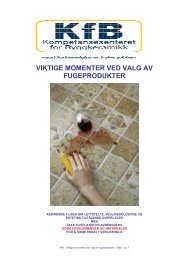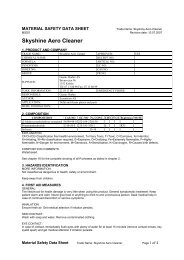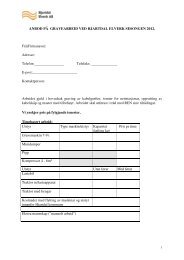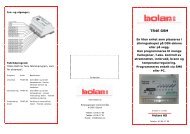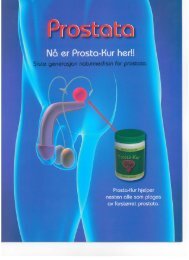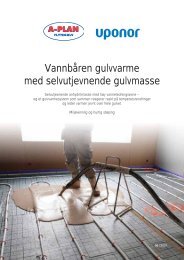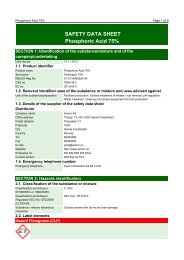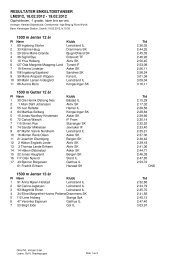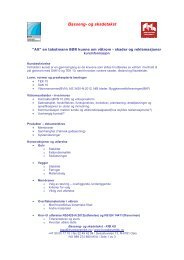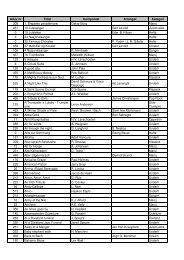SAFETY DATA SHEET Hydrochloric Acid 32 - 36%
SAFETY DATA SHEET Hydrochloric Acid 32 - 36%
SAFETY DATA SHEET Hydrochloric Acid 32 - 36%
- No tags were found...
Create successful ePaper yourself
Turn your PDF publications into a flip-book with our unique Google optimized e-Paper software.
<strong>Hydrochloric</strong> <strong>Acid</strong> <strong>32</strong> - <strong>36%</strong> Page 1 of 8<strong>SAFETY</strong> <strong>DATA</strong> <strong>SHEET</strong><strong>Hydrochloric</strong> <strong>Acid</strong> <strong>32</strong> - <strong>36%</strong>SECTION 1: Identification of the substance/mixture and of thecompany/undertakingDate issued 19.11.20121.1. Product identifierProduct name <strong>Hydrochloric</strong> <strong>Acid</strong> <strong>32</strong> - <strong>36%</strong>Synonyms Saltsyre <strong>32</strong> - <strong>36%</strong>REACH Reg No 01-2119484862-27EC no. 231-595-71.2. Relevant identified uses of the substance or mixture and uses advised againstUse of the substance/preparation pH regulation. Production of PVC. <strong>Acid</strong>ity substance in food.1.3. Details of the supplier of the safety data sheetDistributorCompany nameOffice addressAcinor ASTitangt. 13, NO-1630 Gamle FredrikstadPostal address Titangaten 13Postcode 1630CityGamle FredrikstadCountryNorwayTel 69384082Fax 69384084E-mailpost@acinor.noWebsitehttp://www.acinor.noEnterprise no.NO 984 648 <strong>32</strong>4 MVAContact personRolf Egil de Flon1.4. Emergency telephone numberEmergency telephone Toxic Information:22 59 13 00SECTION 2: Hazards identification2.1. Classification of the substance or mixtureClassification according to67/548/EEC or 1999/45/ECClassification according toRegulation (EC) No 1272/2008[CLP/GHS]Substance / mixture hazardousproperties2.2. Label elementsHazard Pictograms (CLP)Xi; R37C; R34Skin Corr 1B; H314;STOT SE3; H335;Causes severe skin burns and eye damage. Irritating to respiratory system.Composition on the label <strong>Hydrochloric</strong> acid ...%: 35 %Signal wordDanger
<strong>Hydrochloric</strong> <strong>Acid</strong> <strong>32</strong> - <strong>36%</strong> Page 2 of 8Hazard statementsPrecautionary statements2.3. Other hazardsPBT / vPvBH314 Causes Severe skin burns and eye damage.H335 May cause respiratory irritation.P260 Do not breathe dust/fume/gas/mist/vapours/spray.P271 Use only outdoors or in a well-ventilated area.P280 Wear protective gloves/protective clothing/eye protection/face protection.P305 + P351 + P338 IF IN EYES: Rinse cautiously with water for severalminutes. Remove contact lenses, if present and easy to do. Continue rinsing.P310 Immediately call a POISON CENTER or doctor/physician.P405 Store locked up.PBT/vPvB assessment has not been performed.SECTION 3: Composition/information on ingredients3.1. SubstancesComponent name Identification Classification ContentsWater CAS no.: 77<strong>32</strong>-18-5EC no.: 231-791-2<strong>Hydrochloric</strong> acid ...% EC no.: 231-595-7Index no.: 017-002-01-XSynonyms: Hydrogen chloride,gas and aerosol mistsComponent commentsC; R34Xi; R37Skin Corr. 1B; H314STOT SE 3; H335See section 16 for explanation of H- and R-phrases listed above.SECTION 4: First aid measures4.1. Description of first aid measuresGeneralIf in doubt, seek medical advice.InhalationSkin contactEye contactIngestion65 %35 %Remove victim immediately from source of exposure. Fresh air and rest.Rinse nose and mouth with water. Contact physician if irritation continues. Forbreathing difficulties oxygen may be necessary.Remove contaminated clothing. Flush skin thoroughly with water. Important toremove the substance from the skin immediately. Get medical attention.Chemical burns must be treated by a physician. Wash contaminated clothesbefor reuse.Promptly rinse eyes with plenty of water (tempered at 20-30°C) for at least15 minutes. Remove contact lenses and open eyes wide apart. Immediatelyconsult a doctor. Transport to physician. Keep on flushing during transport.DO NOT INDUCE VOMITING! Rinse mouth thoroughly. Drink a few glassesof water or milk. Do not give victim anything to drink if he is unconscious.Immediately consult a doctor. Transport to hospital. Bring the safety datasheet.4.2. Most important symptoms and effects, both acute and delayedInformation for health personnel Treat Symptomatically.Acute symptoms and effectsDelayed symptoms and effectsCorrosive. Forms blisters and can cause ulceration.Corrosive to the eyes, danger of vision impairment / blindness, burning nose,chemical burns to the skin.Causes burns if swallowed. Causes burning sensation in the mouth, throatand esophagus. May cause serious permanent damage.Inhalation: The product irritates the airways and can cause itching, burningand cough. May cause chemical burns to the respiratory tract.Prolonged or repeated exposure can cause permanent damage.4.3. Indication of any immediate medical attention and special treatment neededOther InformationSplashes in the eyes and ingestion of more than an insignificant amountrequires immediate medical attention. Corrosive burns on the skin must betreated as thermal burns.
<strong>Hydrochloric</strong> <strong>Acid</strong> <strong>32</strong> - <strong>36%</strong> Page 3 of 8SECTION 5: Firefighting measures5.1. Extinguishing mediaSuitable extinguishing mediaImproper extinguishing mediaUse fire-extinguishing media appropriate for surrounding materials.Do not use water jet.5.2. Special hazards arising from the substance or mixtureFire and explosion hazardsThe product is not classified as flammable.Hazardous combustion products Hydrogen chloride (HCl). Corrosive gases/vapours/fumes.5.3. Advice for firefightersPersonal protective equipmentOther InformationUse compressed air equipment when the product is involved in fire. In caseof evacuation, an approved protection mask should be used. See also section8.Containers close to fire should be removed immediately or cooled with water.Spill water from fire fighting may be strongly caustic.SECTION 6: Accidental release measures6.1. Personal precautions, protective equipment and emergency proceduresPersonal precautions Use protective equipment as referred to in section 8.Provide adequate ventilation.Avoid inhalation of spray mist and contact with skin and eyes.6.2. Environmental precautionsEnvironmental precautionsDo not allow to enter into sewer, water system or soil.6.3. Methods and material for containment and cleaning upMethods for cleaningCleaning up6.4. Reference to other sectionsOther instructions See also sections 8 and 13.Absorb in vermiculite, dry sand or earth and place into containers. Collect ina suitable container and dispose as hazardous waste according to section 13.Limit spread of spilled material.SECTION 7: Handling and storage7.1. Precautions for safe handlingHandling Use protective equipment as referred to in section 8.Provide adequate ventilation.Avoid inhalation of vapours/spray and contact with skin and eyes.Avoid direct contact.Never pour water into acid/base. Dilute by slowly pouring the product intowater while stirring.Be aware of the risk of exotermic reactions.Immediately change contaminated clothes.Protective MeasuresAdvice on general occupationalhygiene7.2. Conditions for safe storage, including any incompatibilitiesStorageHints on storage assembly7.3. Specific end use(s)Specific use(s) See section 1.2.Wash hands at the end of each work shift and before eating, smoking andusing the toilet. Do not eat, drink or smoke during work.Store in a tightly closed container in a cool, well-ventilated room, protectedfrom direct sunlight. Store in a dry place. Corrosive storage.Keep away from: Bases/alkalies (organic). Bases/alkalies (inorganic).SECTION 8: Exposure controls/personal protection8.1. Control parameters
<strong>Hydrochloric</strong> <strong>Acid</strong> <strong>32</strong> - <strong>36%</strong> Page 4 of 8Other Information about thresholdlimit valuesCAS-nr.:7647-01-0 has got note T.T = ceiling valueExposure limit valuesComponent name Identification Value YearHydrogen chloride (gas and aerosolmists)CAS no.: 7647-01-0EC no.: 231-595-78 h.: 5 ppm8 h.: 7 mg/m³20118.2. Exposure controlsOccupational exposure controlsRespiratory protectionRespiratory protectionHand protectionHand protectionSuitable gloves typeBreakthrough timeEye / face protectionEye protectionSkin protectionSkin protection (other than of thehands)Additional skin protection measuresOther InformationOther InformationProvide adequate ventilation. Personal protection equipment should be chosenaccording to the CEN standards and in discussion with the supplier of thepersonal protective equipment.In case of inadequate ventilation or risk of inhalation of vapours, use suitablerespiratory equipment with combination filter (type B2/P2). Self-containedbreathing apparatus.Use chemical resistant gloves.Polyvinyl chloride (PVC). Neoprene. Nitrile. Butyl rubber.Penetration time is not known. The recommended material of gloves isrecommended after a study of the single components in the product.Use approved safety goggles or face shield.Wear appropriate clothing to prevent any possibility of skin contact.Wash promptly if skin becomes wet or contaminated. Promptly remove anyclothing that becomes wet or contaminated.Eye wash facilities and emergency shower should be available when handlingthis product. The listed protective equipment is a recommendation. A riskassessment of the actual risk may lead to other requirements.SECTION 9: Physical and chemical properties9.1. Information on basic physical and chemical propertiesPhysical stateFluid.ColourColourless. Light yellow.OdourPungent odour.Comments, Odour limitNot known.pH (as supplied) Value: < 2Melting point/melting range Value: -70 °CComments, Melting point / melting Freezing point.rangeBoiling point / boiling range Value: 110 °CComments, Flash pointNot known.Comments, Evaporation rate Not known.Flammability (solid, gas)Not known.Comments, Explosion limitNot known.Vapour pressureValue: 215 mmHgComments, Vapour densityNot known.Specific gravityValue: 1,1-1,2 g/cm³Test temperature: 20 °CComments, Specific gravityValid for density.Solubility in waterSoluble.
<strong>Hydrochloric</strong> <strong>Acid</strong> <strong>32</strong> - <strong>36%</strong> Page 5 of 8Comment, SolubilityComments, Partition coefficient: n-octanol / waterComments, SpontaneouscombustabilityComments, DecompositiontemperatureComments, ViscosityPhysical hazardsExplosive propertiesOxidising propertiesSoluble in: Alcohol.Not known.Not known.Not known.Not known.Not known.Not known.9.2. Other informationOther physical and chemical propertiesPhysical and chemical properties Not known.SECTION 10: Stability and reactivity10.1. ReactivityReactivity Reactive with the materials listed in Section 10.5.10.2. Chemical stabilityStability10.3. Possibility of hazardous reactionsPossibility of hazardous reactions10.4. Conditions to avoidConditions to avoidStable under normal temperature conditions and recommended use.Arise in contact with incompatible materials (section 10.5) and inappropriateconditions (section 10.4).Do not add water directly to the product. It may cause a violent reaction.Generates heat upon contact with water.10.5. Incompatible materialsMaterials to avoidBases, alkalis (organic). Bases, alkalis (inorganic).10.6. Hazardous decomposition productsHazardous decomposition products None under normal conditions. See also section 5.2.SECTION 11: Toxicological information11.1. Information on toxicological effectsToxicological Information:LD50 oralValue: 900 mg/kgTest animal species: RatComments: (25% solution).Other information regarding health hazardsGeneralThis substance is corrosive.Potential acute effectsInhalationSkin contactEye contactIngestionAspiration hazardIrritating to respiratory system. Vapours are corrosive. After 24-36 hours,injured persons may develop serious shortness of breath and lung oedema.Corrosive. Prolonged contact causes serious tissue damage. Cause blistersand burns.Corrosive. Immediate first aid is necessary. Risk of serious damage to eyes.Risk of permanent corneal damage, loss of sight and blindness.Causes burns if swallowed. Causes burning sensation in the mouth, throatand esophagus. May cause serious permanent damage. May cause burns inmucous membranes, throat, oesophagus and stomach.Not classified with respect to aspiration toxicity. The classification criteria arenot met.
<strong>Hydrochloric</strong> <strong>Acid</strong> <strong>32</strong> - <strong>36%</strong> Page 6 of 8Delayed effects / repeated exposureSensitisationCarcinogenic, Mutagenic or ReprotoxicCarcinogenicityMutagenicityTeratogenic propertiesReproductive toxicitySECTION 12: Ecological information12.1. ToxicityEcotoxicityNone of the substances mentioned in section 3 is considered to havesensitizing effects according to current labelling rules.None of the substances mentioned in section 3 is considered as carcinogenicaccording to current labelling rules.None of the substances mentioned in section 3 are considered to havemutagenic or pro-mutagenic effects.None of the substances mentioned in section 3 are considered to cause harmto the unborn child.None of the substances mentioned in section 3 are considered to havegenotoxic effects.The product is not classified as dangerous for the environment. The productmay affect the acidity (pH-factor) in water with risk of harmful effects toaquatic organisms. Evalute the necessity of neutralization.12.2. Persistence and degradabilityPersistence and degradability The product contains inorganic compounds that are not biodegradable.12.3. Bioaccumulative potentialBioaccumulative potentialProduct is not expected to be bioaccumulative.12.4. Mobility in soilMobilityThe product is soluble in water.12.5. Results of PBT and vPvB assessmentPBT assessment resultsPBT assessment has not been performed.vPvB evaluation resultsvPvB assessment has not been performed.12.6. Other adverse effectsOther adverse effects / RemarksSECTION 13: Disposal considerations13.1. Waste treatment methodsSpecify the appropriate methods ofdisposalProduct classified as hazardouswasteEWC waste codeNORSAS<strong>Acid</strong>s cause decreased pH values in the water. A low pH value harmsaquatic organisms. Do not allow to enter into sewer, water system or soil.Disposed of as hazardous waste by approved contractor. The waste code(EWC-Code) is intented as a guide. The code must be chosen by the user,if the use differs from the one mentioned above.YesEWC: 06 01 02 hydrochloric acid7131 <strong>Acid</strong>s, inorganic.SECTION 14: Transport information14.1. UN numberADR 1789RID 1789IMDG 1789ICAO/IATA 178914.2. UN proper shipping nameADRHYDROCHLORIC ACIDRIDHYDROCHLORIC ACIDIMDGHYDROCHLORIC ACID
<strong>Hydrochloric</strong> <strong>Acid</strong> <strong>32</strong> - <strong>36%</strong> Page 7 of 8ICAO/IATA14.3. Transport hazard class(es)ADR 8Hazard no. 80RID 8IMDG 8ICAO/IATA 814.4. Packing groupADRIIIRIDIMDGICAO/IATAHYDROCHLORIC ACIDIIIIIIIII14.5. Environmental hazardsIMDG Marine pollutantNo14.6. Special precautions for userADR Other applicable information Classification code: C1EmSF-A, S-B14.7. Transport in bulk according to Annex II of MARPOL 73/78 and the IBC CodeOther applicable information.Other applicable information. Not relevant.SECTION 15: Regulatory informationEC no. 231-595-715.1. Safety, health and environmental regulations/legislation specific for thesubstance or mixtureReferences (laws/regulations)Norwegian regulation on classification and labeling of dangerous chemicals.Valid from June 21, 2010.Regulation on classification, labeling and packaging of substances andmixtures (CLP) dated 16.06.2012.Commission Regulation (EU) No 453/2010 amending Regulation (EC) No1907/2006 of the European Parliament and of the Council on the Registration,Evaluation, Authorisation and Restriction of Chemicals (REACH), Annex IISafety Data Sheets.Administrative norms for pollution of the atmosphere, the latest edition, fromNorwegian labour inspection authorityNorwegian regulations on waste, no. 930/2004, from Minestry of theEnvironment.Dangerous Goods regulationsThe Safety Data Sheet is based on information provided by the producer.Declaration no. 30213115.2. Chemical safety assessmentChemical safety assessment hasbeen carried outNoSECTION 16: Other informationSupplier's notesClassification according toRegulation (EC) No 1272/2008[CLP/GHS]List of relevant R phrases (underThe information contained in this SDS must be made available to all thosewho handle the product.Skin Corr 1B; H314;STOT SE3; H335;R34 Causes burns.
<strong>Hydrochloric</strong> <strong>Acid</strong> <strong>32</strong> - <strong>36%</strong> Page 8 of 8headings 2 and 3).List of relevant H-phrases (Section2 and 3).Abbreviations and acronyms usedSources of key data used tocompile the safety data sheetInformation which has been added,deleted or revisedChecking quality of informationResponsible for safety data sheetPrepared byR37 Irritating to respiratory system.H314 Causes Severe skin burns and eye damage.H335 May cause respiratory irritation.PBT: Persistent, Bioaccumulative and ToxicvPvB: very Persistent and very BioaccumulativeLD50: Lethal dose, is the amount of a substance given to a group of testanimals, which causes the death of 50%.Suppliers Safety data sheet dated: 06.01.2011New Safety Data Sheet.This SDS is quality controlled by National Institute of Technology in Norway,certified according to the Quality Management System requirements specifiedin ISO 9001:2008.Acinor ASNational Institute of Technology as, Norway v/ Camilla M. Ormset




